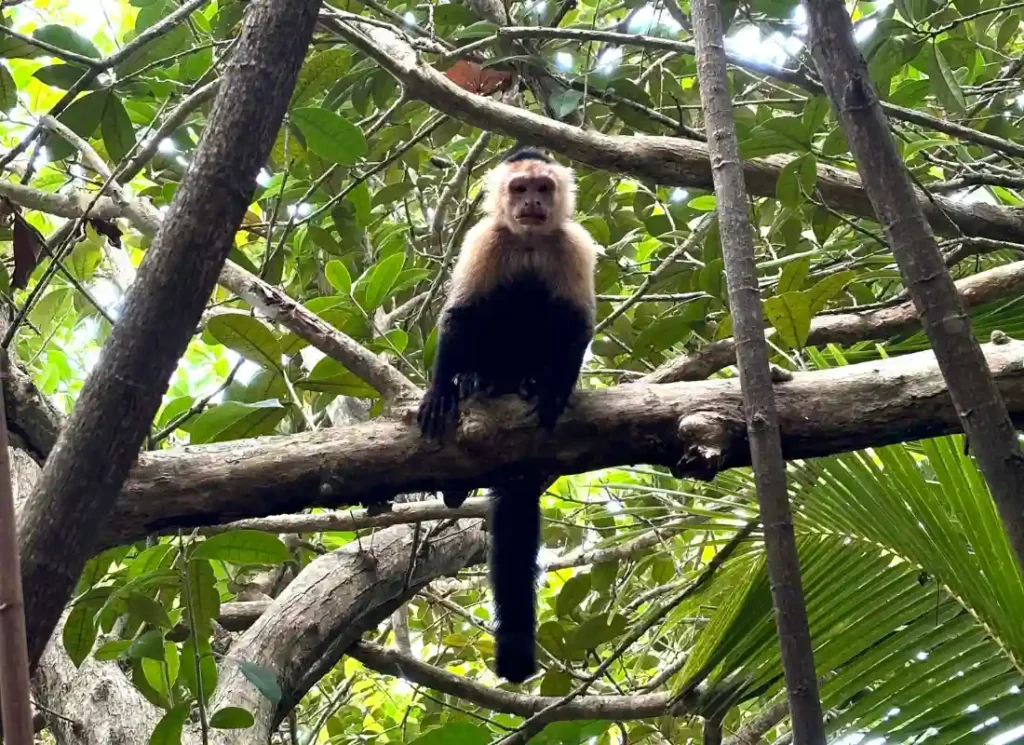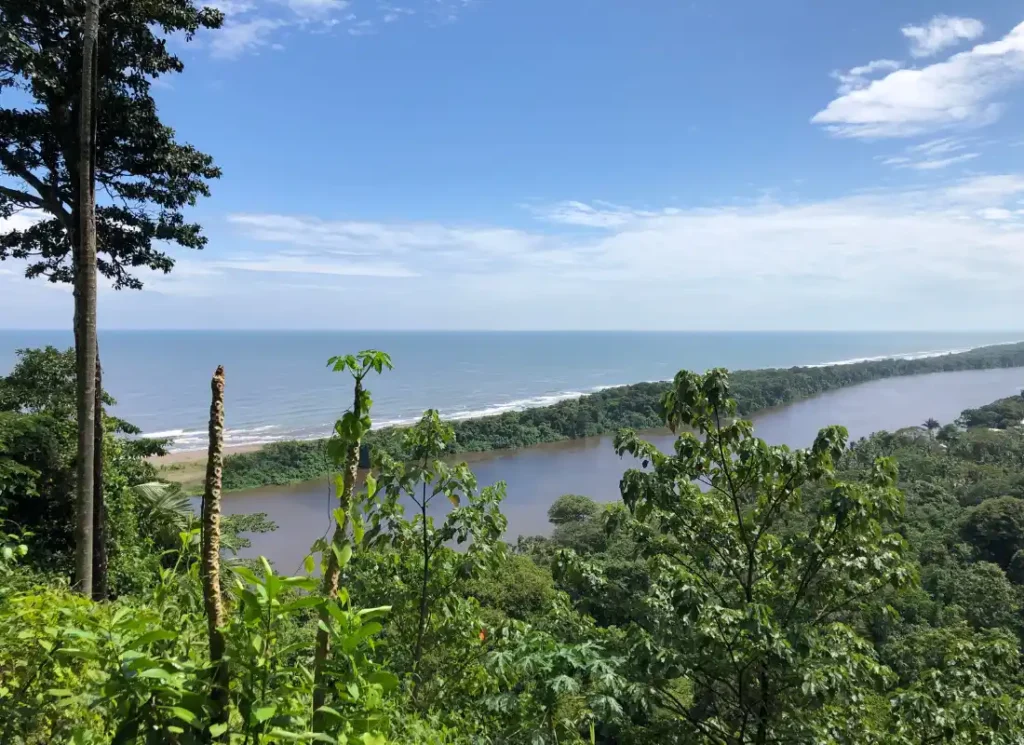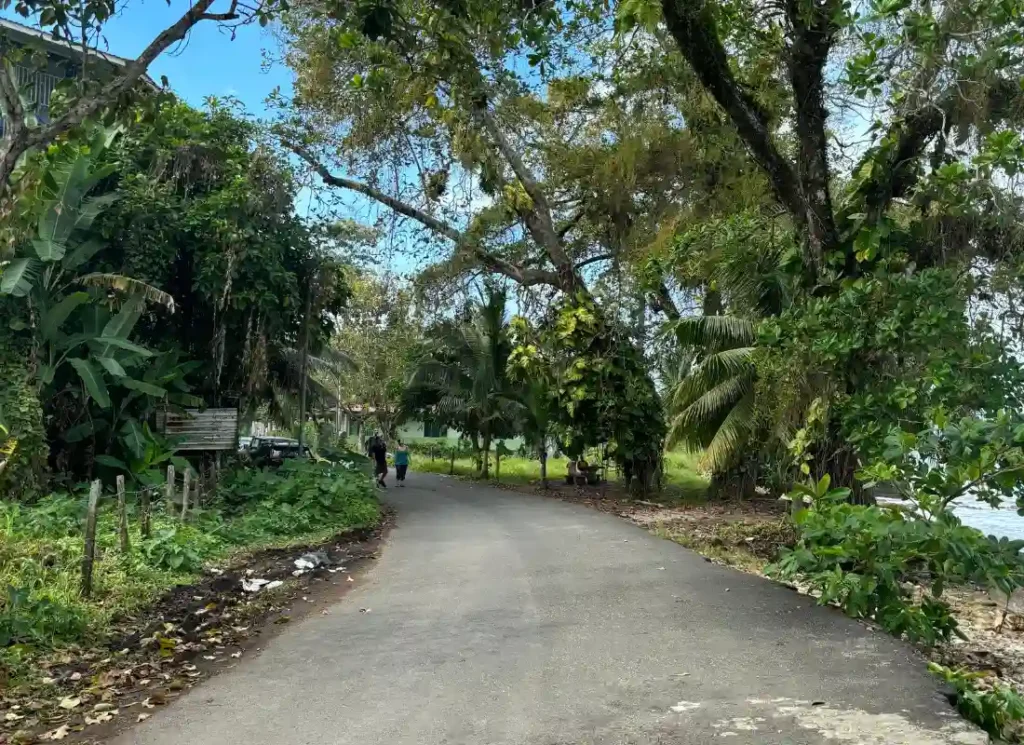Everything you need to know for your backpacking trip in Costa Rica! What’s the best time to go, and where can you find vegetarian or vegan food? What is the currency in Costa Rica, and do you need to protect yourself against mosquitos? And more questions answered about backpacking in Costa Rica in this ultimate guide.
Click here for your guide to planning an itinerary in Costa Rica.
San José
San Jose is the capital of Costa Rica, and it’s likely to be your first stop when you arrive! The city is generally safe, but it does have some dodgy areas, so be careful when choosing your accommodation if you’re booking an Airbnb. A safe rule of thumb I usually go by is to see where there are clusters of hostels and hotels; these are usually the safest areas.
In San Jose, the dodgiest areas are in the north west, by the bus stations. There’s not a ton to do in San Jose, so I’d recommend staying for a night or two at most and then moving on to somewhere else. If you’re short on time, read my 10-Day Costa Rica itinerary.
La Fortuna & Arenal Volcano
La Fortuna is a popular starting point for many travellers due to its proximity to the Arenal Volcano. There’s plenty to do, from hiking and hot springs to waterfall rappelling. It’s a great spot to meet fellow travellers and enjoy the natural beauty of Costa Rica, especially if you’re into outdoor activities (other than surfing, of course, in which case I have other recommendations for you!).
Monteverde Cloud Forest Reserve
Monteverde is known for its lush cloud forests and abundant wildlife. It’s a must-visit for nature lovers and offers various activities like zip-lining, hanging bridges, and guided night tours. The town itself is small and charming, making it easy to get around, but it is slightly colder than other spots in Costa Rica due to its elevation. (Note, it’s not a high-altitude town, just a little higher than some other spots).
Manuel Antonio National Park
Manuel Antonio is famous for its beautiful beaches and wildlife, including monkeys and sloths which literally just hang out with you in the town centre. The national park offers great hiking trails and stunning ocean views (it can be quite touristy, but the natural beauty makes it worthwhile). If you’re into surfing and don’t have time to go over to the Nicoya Peninsula, then Manuel Antonio should be a must-see on your list!
Tamarindo
A bustling beach town on the Pacific Coast of the Nicoya Peninsula, Tamarindo is known for its surfing and great nightlife. It’s a great spot to learn how to surf (or hit some bigger waves, if you’re an experienced surfer), enjoy some beach time, and head to some beach parties.
Tortuguero National Park
Accessible only by boat or small plane, Tortuguero is often referred to as the “Amazon of Costa Rica.” It’s on the Caribbean coast of Costa Rica and is one of the best places to see nesting sea turtles in Central America (hence the name, which literally means “land of turtles” in Spanish). You won’t find it in many Costa Rica itineraries because it’s just so difficult to get there, but if you have the time then I would highly recommend it! There are also some great hikes to do in this area.
Puerto Viejo
Further south on the Caribbean Coast is Puerto Viejo, a four hour bus ride from San Jose and actually not so far from Costa Rica’s border with Panama. Over the past couple of years it’s become a vibrant, touristy beach town with great access to Cahuita National Park (where you’re likely to set your eyes on some howler monkeys), some fantastic beaches, and a direct transfer to Bocas del Toro in Panama.
Santa Teresa
Santa Teresa is another beach town on the Nicoya Peninsula, which is super popular with surfers. Although it does have a decent set-up for tourists, it’s not as busy as many other touristy areas in Costa Rica because it’s quite out of the way. It’s a good place to go if you have plenty of time and want to surf without being surrounded by crowds of tourists! There are also a lot of surf schools in Santa Teresa.
Costa Rica borders two different countries: Nicaragua and Panama.
All of the borders in Central America are similar to cross, but each one has its difficulties, so make sure you check entry requirements carefully before attempting to cross any border. Personally, I crossed the Costa Rica – Nicaragua border by public bus, and the Costa Rica – Panama border with a private shuttle transfer, and both times I had no issues crossing the border.
Always remember to get your passport stamped!
Costa Rica-Nicaragua border
The main crossing points are Peñas Blancas on the Pacific side and Los Chiles in the north. Peñas Blancas is the more popular route, often used by travellers heading to or from San Juan del Sur in Nicaragua. Be prepared for a sometimes lengthy process because the queues can be long, and ensure all your paperwork is in order. At the time of writing you need to show an exit ticket to enter into Costa Rica, and have the name of your accommodation to hand. But, always check on the official government website of your country before making any border crossing.
Costa Rica-Panama border
The busiest crossing point is Paso Canoas on the Pacific side of Costa Rica, but many tourists cross at the Sixaola crossing on the Caribbean coastline of Costa Rica, because it joins the towns of Puerto Viejo and Bocas del Toro in Panama. We took a tourist shuttle transfer from Puerto Viejo to Bocas del Toro and, well, it was kind of chaos, but the border crossing was simple and we got there in the end! Make sure to check the latest entry requirements before you cross. When I went, we had to show proof of our accommodation and an exit ticket from Panama.
Everything You Need to Know About Travelling in Costa Rica in January!
Touristy Seasons in Costa Rica
There are two main touristy seasons in Costa Rica: the first is December to April, which coincides with the dry season, and the second is July to August, coinciding with summer holidays in Europe and North America. Expect to pay more for flights, transfers, and accommodation around these times.
Rainy Season in Costa Rica
The rainy season in Costa Rica is from May to November, with the heaviest rainfall in September and October. During this time, the climate is more humid and cloudier, but the lush landscapes are incredibly vibrant. I went to Costa Rica around October/November time and we got pretty lucky with the rain – yes, it did rain some days, but it didn’t totally ruin the trip!
Dry Season in Costa Rica
The dry season runs from December to April, with January and February being ideal months to visit. The weather is warm and sunny, perfect for beach trips and outdoor activities. It also tends to get hotter during this season, however Costa Rica is warm the whole year round.
Sunrise & Sunset in Costa Rica
Being close to the equator, there is not much variation in sunrise and sunset times throughout the year. Sunrise in Costa Rica is between 5:30 and 6:30 am daily, and sunset is between 5:30 and 6:30 pm, giving you around 12 hours of daylight per day.
Public Buses
Public buses in Costa Rica are reliable and cover most of the country. They are an affordable way to travel, and generally much safer than public buses in other parts of Central America. Costa Rica is the only country where I’d recommend taking the public bus even if you’re conscious about safety, because they really are safe and tourist shuttle buses can be out-of-this-world expensive! The main problem with them is that you can’t book online, so if you want to book in advance you have to make an additional trip to the bus station.
Boats
Boat transportation is the most common way to get to Tortuguero, and they’re a pretty common option for travelling to the Nicoya Peninsula too. They’re generally a safe and scenic way to travel. Just make sure to waterproof your belongings first!
Shuttle Buses (Tourist Shuttle)
Tourist shuttles are a popular option for getting around Costa Rica. They can be booked through your accommodation or online and offer a convenient and safe way to travel, but they are becoming increasingly expensive as Costa Rica becomes a more and more popular destination.
Taxis
Taxis are widely available in Costa Rica, and official taxis are red with a yellow triangle, but I’d always recommend to book one with your accommodation rather than flagging one down in the street. Uber is technically illegal in Costa Rica, but it still operates widely especially in the larger cities. Tourists and Costa Ricans alike use it regularly as a safe form of transport, but because it is illegal drivers generally prefer you to sit in the front seat, to make it look less suspicious to the police.
Everything You Need to Know About Travelling in Costa Rica in February!
Vegetarians & Vegans
Costa Rica is a great destination for vegetarians and vegans. The national dish, Gallo Pinto, is vegetarian, and you’ll find plenty of rice, beans, and plantains in other dishes, too. Many restaurants offer vegetarian and vegan options, especially in San Jose and touristy areas.
Is Street Food Safe?
Street food in Costa Rica is generally safe to eat, but use common sense. Look for busy stalls with high turnover to ensure that the food is fresh. Avoid anything uncooked like fruit, smoothies or salads, and opt for fully cooked items instead.
Can You Drink Tap Water in Costa Rica?
Yes, tap water is generally safe to drink in most parts of Costa Rica, with the exception of Puerto Viejo on the Caribbean coast. However, if you’re in a remote area, it’s best to ask locals or use bottled water just in case. Keep an eye on the news and ask around! The last time I was in San Jose, I woke up one morning and was convinced the water tasted weird. Later that day a friend texted me a news report that petrochemicals had been found in the water in San Jose and it was temporarily unsafe to drink! I’m pretty sure this was a freak accident, but make sure you keep an eye out for this kind of thing when you’re backpacking in Costa Rica.
What Languages Do They Speak in Costa Rica?
The official language of Costa Rica is Spanish, just like most countries in Latin America, but you will find English widely spoken in tourist areas, hotels, and restaurants. In some more remote areas, indigenous languages like Bribri, Maleku and Guaymí are also spoken.
Do People Speak English in Costa Rica?
Yes, most people that work in the tourism industry speak English. While basic Spanish phrases will be helpful, you can get by with English in most tourist destinations.
What is the currency in Costa Rica?
The currency in Costa Rica is the Costa Rican Colón (CRC). At the time of writing you can get around 500 Colones to 1 US Dollar, but check the latest exchange rates before you travel. You can also widely spend US dollars in Costa Rica, with just a few exceptions like local markets and paying for the local bus.
How much does it cost to withdraw money in Costa Rica?
ATM fees in Costa Rica vary, and can be as high as 8-9 US dollars per transaction. Always look out for ATMS from Banco de Costa Rica (BCR) as they offer fee-free withdrawals of both Costa Rican colones and US dollars.
Do they take card in Costa Rica?
Credit and debit cards are widely accepted in hotels, restaurants, and larger shops. However, small businesses, markets, and rural areas may only accept cash. It’s a good idea to carry some local currency for these situations, but you can usually use a card without problems.
Read more: What to Pack for Backpacking in Costa Rica
Tourist Areas & the Tourist Trail
Costa Rica is the safest of all Central American Countries, but it’s always wise to stay alert. Tourist areas like La Fortuna, Monteverde, and Manuel Antonio are generally safe, but petty theft can occur. Keep your valuables secure and be cautious in crowded areas.
Pickpockets
Pickpocketing is the most common crime affecting tourists across Central America, but Costa Rica is the safest country in Central America. Keep your belongings secure, use a money belt, and avoid displaying expensive items. Be especially careful in city centres and around bus stations.
Violent Crime
Violent crime is rare in Costa Rica, especially against tourists, but it’s best to avoid walking alone at night, especially in unfamiliar areas. Stick to well-lit, busy streets and always travel in groups. If you have to travel at night, ask your accommodation to call you a reputable taxi or use Uber.
Taking a Local Guide
Hiring a local guide is a good way to protect your personal safety and to give back to the local community financially! It’s also a great way to make sure you make the most of your trip. Taking a guide is great for hiking and wildlife watching, because they’ll know the best spots for your chance at seeing something great, and sometimes will know common bird calls to increase your chances of seeing rare species.
Can you drink tap water in Costa Rica?
Yes, tap water is generally safe to drink in most parts of Costa Rica, but see my note above on the water on the Caribbean coast and unlikely water-related emergencies!
Travel Insurance & What to do if you get ill
Travel insurance is essential for any trip, including Costa Rica. If you need medical care, it’s best to go to San Jose if possible. I heard a seriously wild story about somebody who was hurt in Cahuita National Park and had a very questionable ambulance ride, and the healthcare they were given there wasn’t up to scratch. I sought private healthcare in San Jose and, whilst it wasn’t the cheapest, the hospital I went to (Hospital Clínica Bíblica) was absolutely great. There’s also an abundance of pharmacies around the city.
Mosquitos
Dengue Fever
Dengue fever is endemic to Costa Rica, which means it’s always present year-round, especially during rainy season. Make sure to use mosquito repellent with DEET in it, and wear long sleeves and pants where possible. If you’re going to the rainforest or cloud forest, your accommodation should provide bug nets, bug screens and/or air conditioning to keep you safe.
Yellow Fever & the Yellow Fever Vaccine
Yellow fever is not present in Costa Rica, but if you’re travelling there from a country with a risk of yellow fever, such as Brazil, you may need proof of vaccination against yellow fever to enter Costa Rica. Check the latest requirements before you travel.








